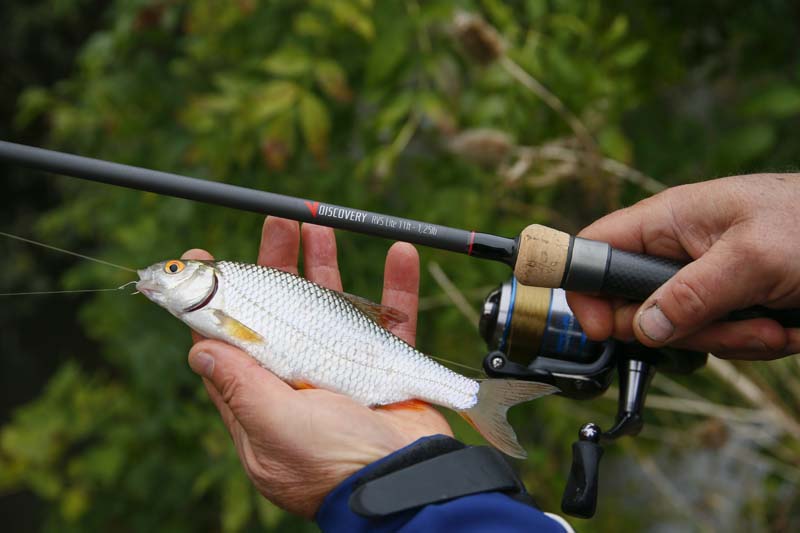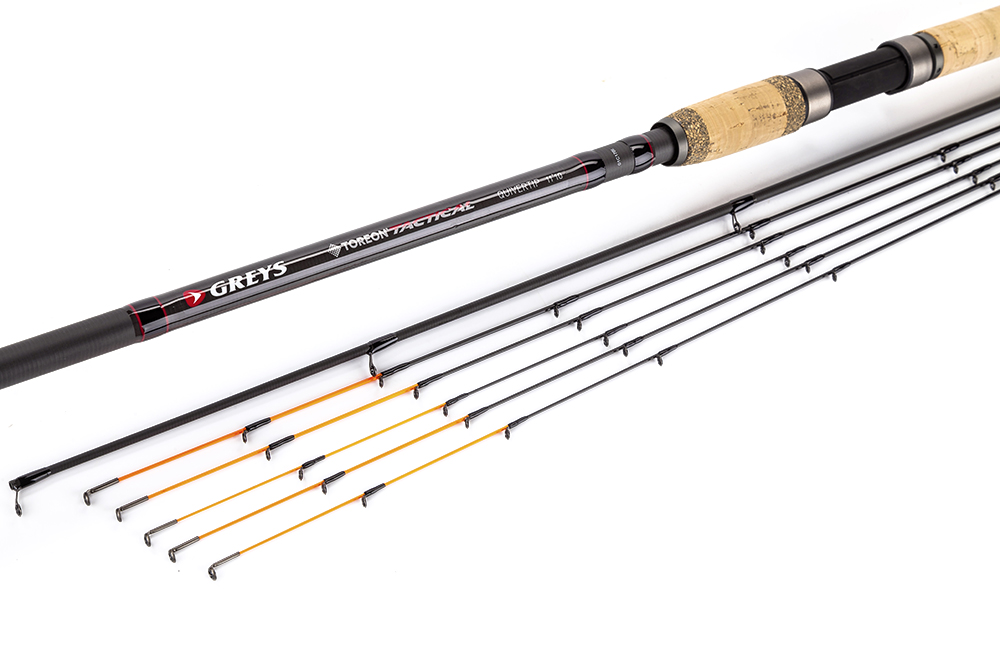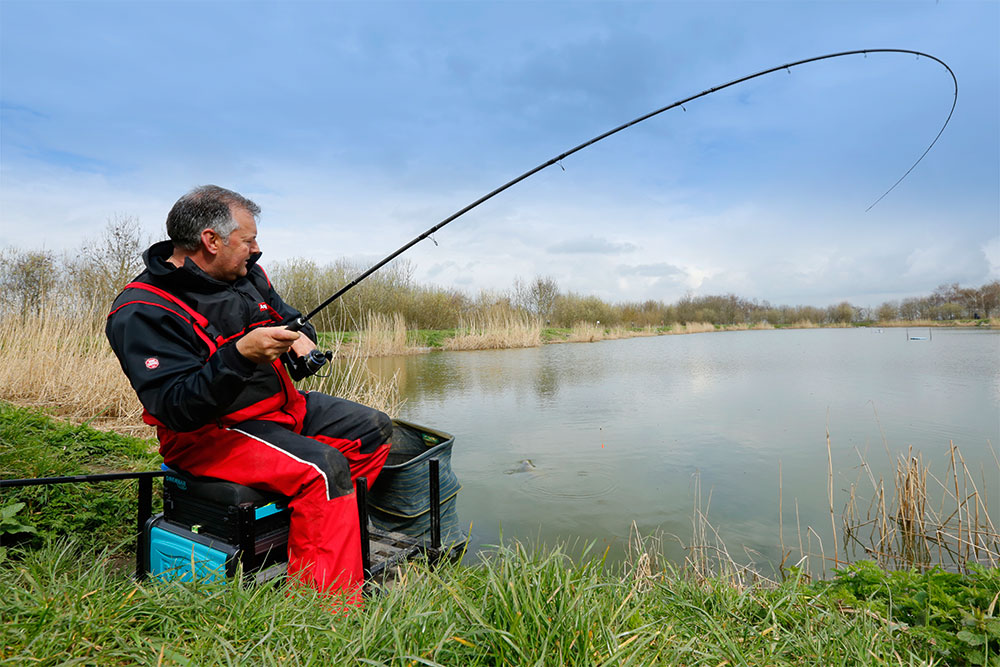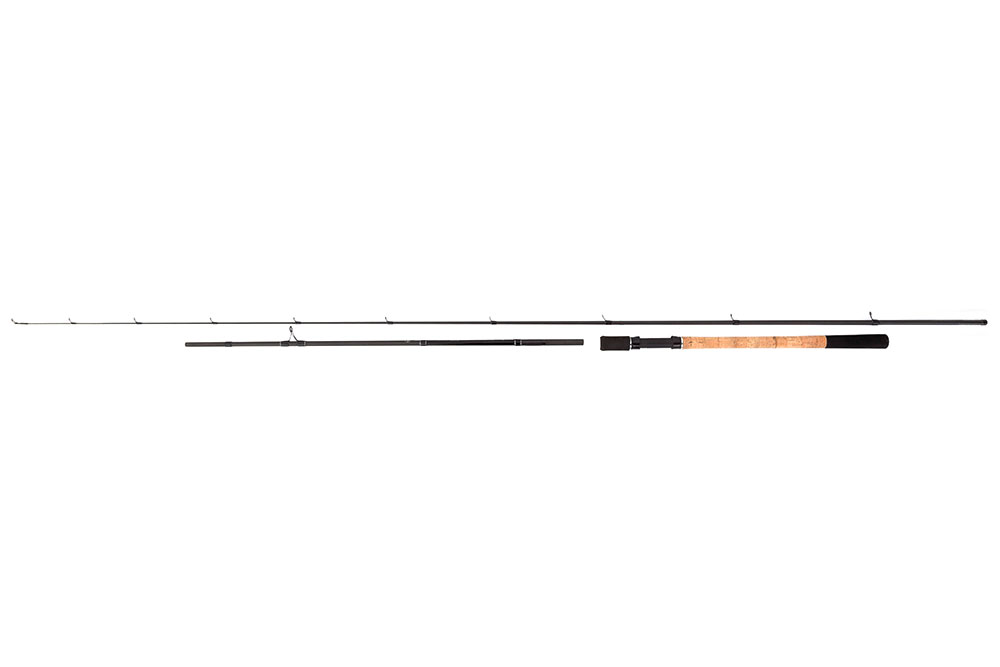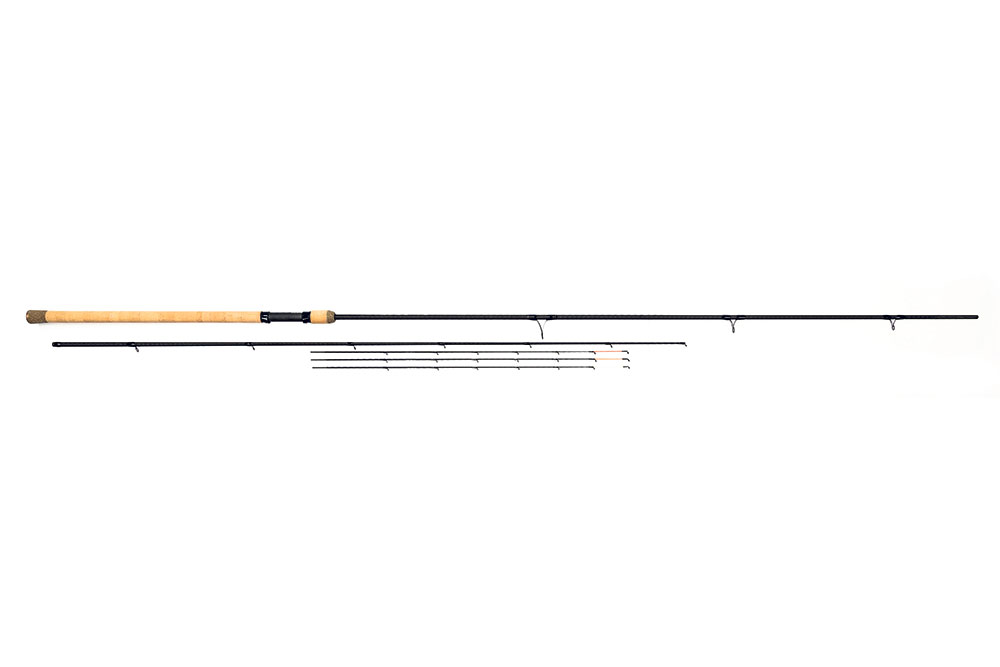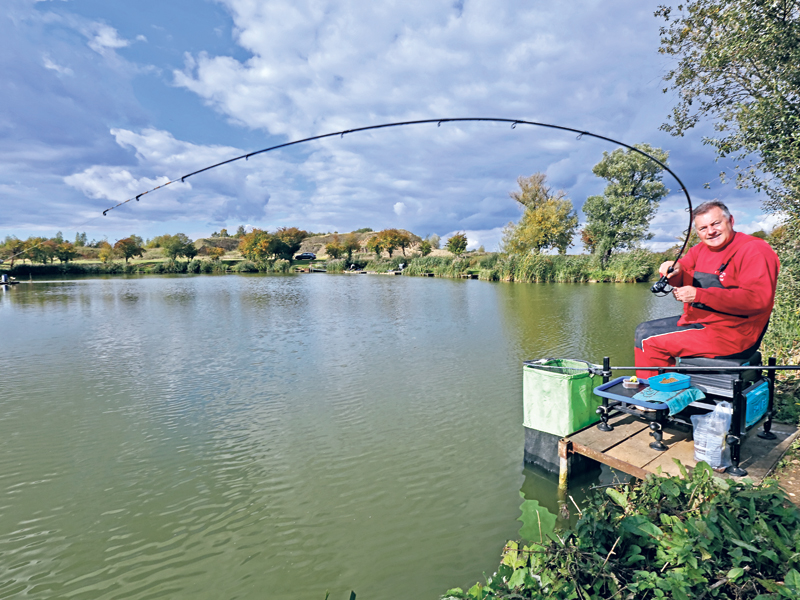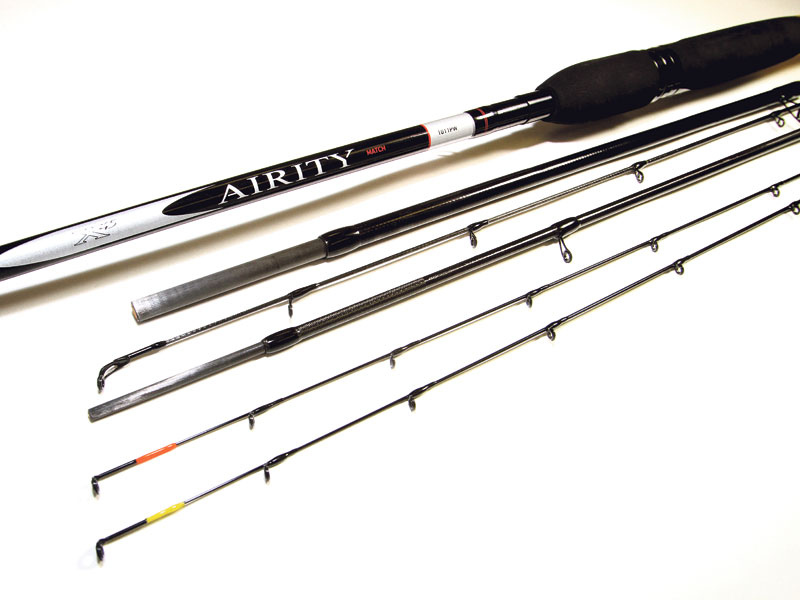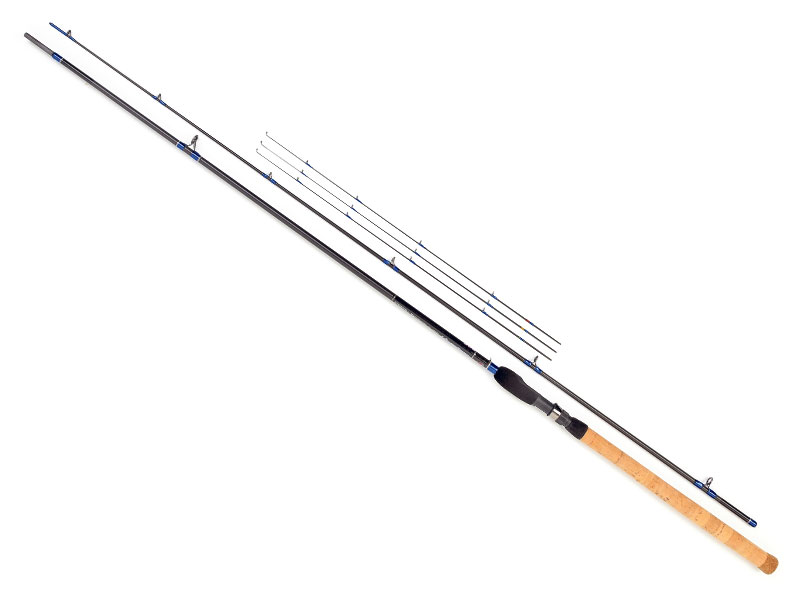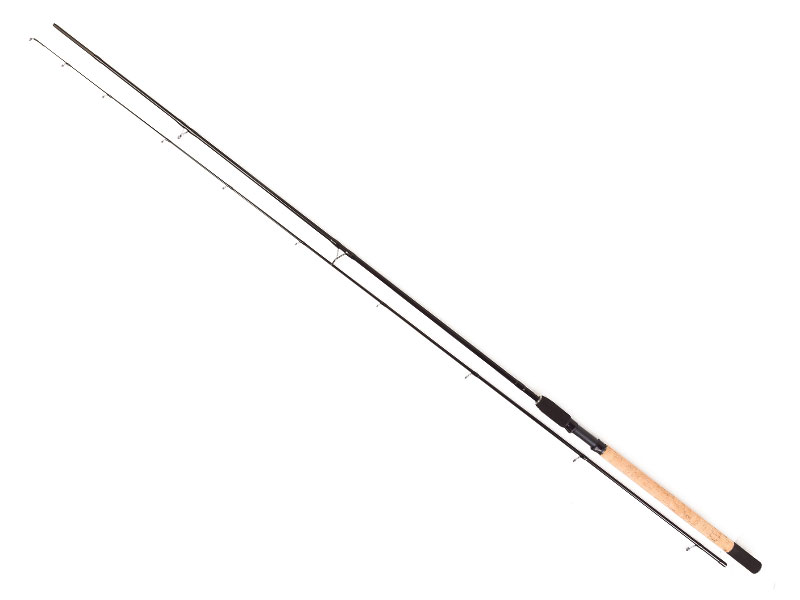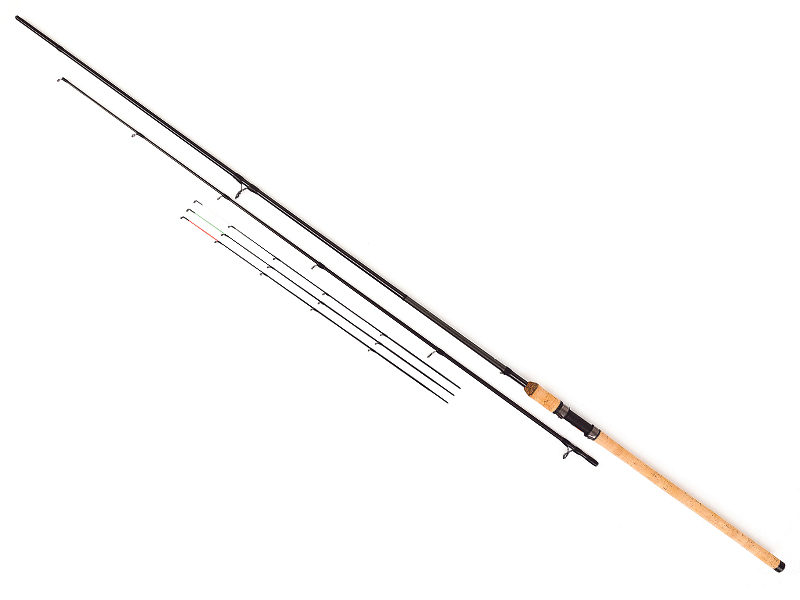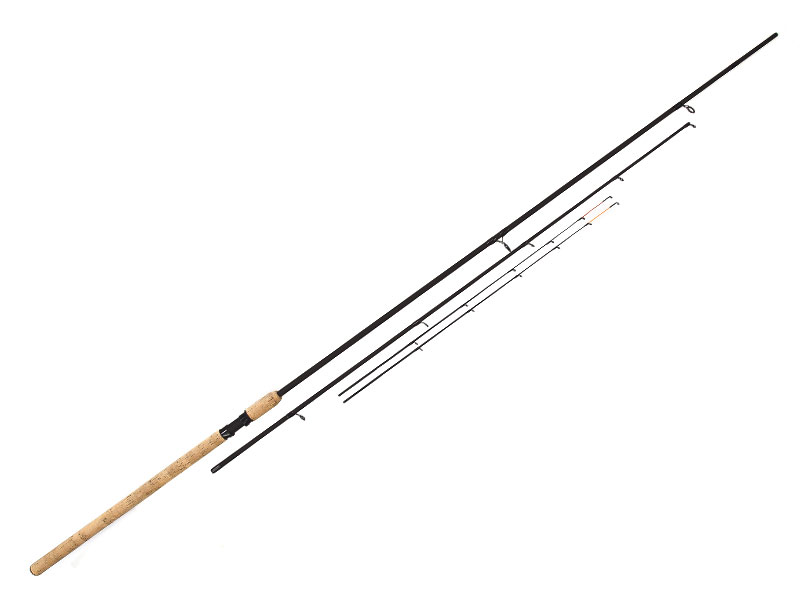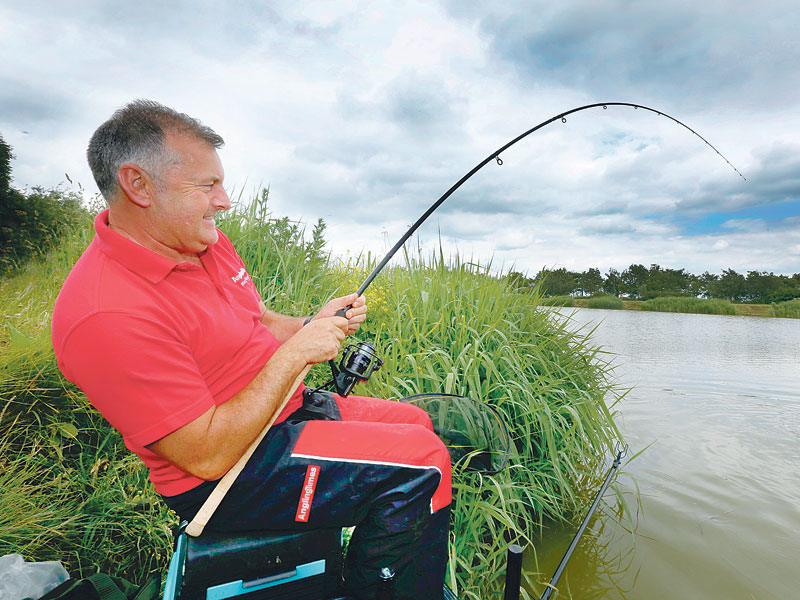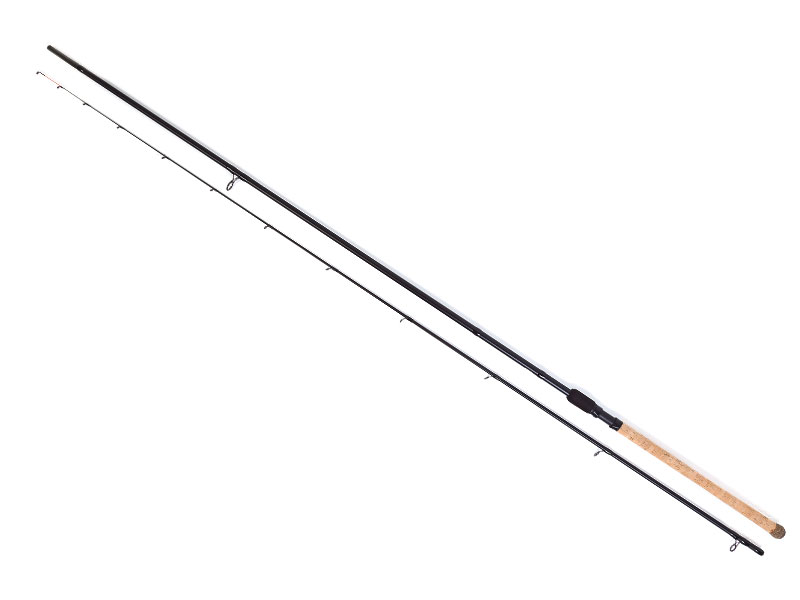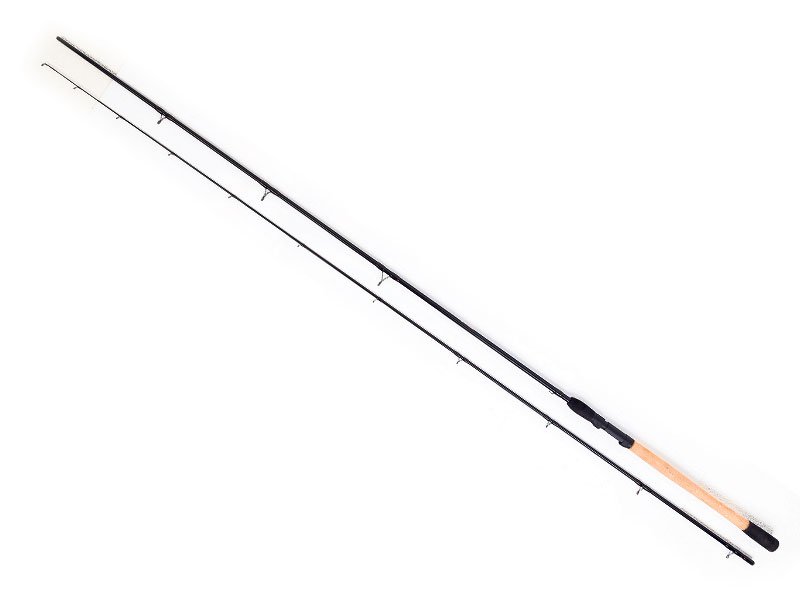Advanta Discovery RVS Twin Tip Lite review
A couple of weeks back I ran the rule over Angling Direct’s own brand Advanta Discovery SU Twin Tip Barbel rod on the River Trent.
Even though I’d been told by a friend just how good the Advanta RVS range was, I was still taken aback by this rod’s build quality and performance – especially at such a modest price.
So, when the 11ft Advanta RVS Twin Tip Lite arrived on my desk with a note extolling its virtues as one of the best small-river chub rods around, I was more than keen to get it out on the bank pronto.
Get your hands on all the latest rods, poles, reels and accessories at this year’s Big One Show
I’m sure many of you reading this can relate to my own angling career. I have spent much of my fishing life on small to medium-sized rivers in pursuit of chub.
In my case this started in my home county of Oxfordshire, biking to the banks of the Evenlode. Then, once I had passed my driving test, my horizons broadened to take in the Cherwell, Windrush and Upper Thames.
No wonder, then, that I have a journeyman’s penchant for small-river chub rods.
I have used everything from expensive hand-built wands to cut-down float rods with spliced-in quivertips. Materials have been as varied as tank aerials, split cane, fibreglass, carbon, boron, carbon composite, in fact Old Uncle Tom Cobley and all. I have fished with the lot at some time!
How many of these rods have I kept? Well, just the one, and it was built at Gloucester Angling Centre at around the turn of the century, or so it now seems.
Anyway, moving on, the build quality of the Advanta Lite is impeccable. This lightweight, highly responsive two-piece rod is made from 30T carbon, with a 1.25lb test curve carrier section that includes 0.5oz, 1oz and 2oz carbon quivertips. There’s also a 1.25lb Avon top that looks ideal for slightly heavier lead tactics or snag fishing.
Without a doubt, the Discovery has been designed by someone with a passion for small rivers, who knows exactly what they are doing. For my money it’s at its best with the carrier section and quivertips fitted.
There’s more than enough casting clout to propel 40g-plus (1.5oz) casting weights, and although it seems dainty, it’s by no means delicate. The blank itself has a through progressive-type action that allows it to be used confidently with hooklengths of around 0.16mm upwards, and hooks as small as a size 16.
I was hugely impressed by the power reserve the blank generates from the bottom of the butt. It certainly has more than enough in its locker to dissuade even the largest of chub from that last-gasp headlong dive into the nearest snag… something all chub have an annoying habit of doing when they are close to the net.
Despite my enthusiasm for the RVS Lite rod, my test session on the upper River Welland above Stamford proved to be a very frustrating few hours.
The gin-clear river was simply heaving with ravenous hordes of roach, pecking away at any bait that hit the water.
Every now and again I would connect with one, and to be fair they were nice fish – but old rubber lips never got so much as a look-in!
Verdict:
WELL, well – what a surprise Angling Direct’s Advanta RVS range is turning out to be!
Make no mistake, this rod is a proper keeper. Well designed, well thought out and well dressed in smart livery, it offers great value for money and is bound to become a sought-after small-river companion for many anglers this winter.
Price: £54.99
Greys Toreon Tactical Quivertip 11ft 10ins rod live test
Wth daylight hours reduced in winter, many anglers, myself included, much prefer to fish short sessions rather than spend days on end sat in a bivvy and carting mountains of tackle around.
It’s much more enjoyable to grab a rod, a net, a small rucksack and a couple of loaves of bread and wander the banks of your local river searching out a chub or two. The Greys Toreon Tactical Quivertip is the perfect tool for this. It's as versatile as a Swiss Army knife.
There are four lengths available in the range – 10ft 6in, 11ft 10in, 12ft 6in and 13ft – to cater for the needs of every stillwater and river coarse angler. They're just as much at home dishing it out on running water as they are bagging up at your local commercial or lobbing out a feeder on a large natural venue.
For this live test I’d chosen the 11ft 10in version, as at this length it’s a great
all-rounder. It’s just about short enough to creep into tight overgrown river swims, although if this is what you're primarily going to be using a rod for then the 10ft 6in model would be recommended.
This is also long enough to chuck a feeder to islands and open swims on commercials. Unlike most feeder rods, which come with two or three push-in tips, the Toreon Tactical Quivertip comes with five, ranging from 0.75oz to 3oz.
The rod also features a detachable butt grip which not only makes it more compact for storage, but also gives you two handle length options. There are nine lightweight gunsmoke SiC line guides on the rod and six equivalent guides on the five quivertips.
To test the rod I headed off to the tiny River Ise in Northamptonshire. This is a tributary of the River Nene and requires a stealthy approach at the best of times to avoid spooking the resident chub.
The fact that the water was fairly low and clear meant I’d have to be extra stealthy. Tactics were kept simple. My reel was loaded with 5lb mainline on to which I threaded a running link leger stopped by a buffer bead over a small swivel.
A piece of breadflake was pinched around a size 10 hook and cast into a deep pool between two shallow stretches of river. I'd baited the mouth of the pool and a couple of other spots along the far-bank reeds with a couple of small balls of mashed bread.
The first few spots didn’t produce a single knock, but a cast towards an overhanging tree saw the tip tremble before it pulled around in a classic chub bite.The fish was quickly steered away from the branches and, after a couple of jagged lunges, a small chub, was drawn over the landing net.
The next two casts produced a couple more chub of a similar size.
THE VERDICT
At almost £140 there are certainly plenty of cheaper rods on the market. But when you look at what you get for your money I think this rod is worth every penny. If you do a spot of river fishing, as well as the odd session on a commercial carp water, and enjoy feeder fishing for bream, it will cover the lot. And the range of five tips supplied with it really do make it suitable to a wide range of duties.
James Furness, Editor, Improve Your Coarse Fishing
TECH SPEC
Length: 11ft 10in
Pieces: Two
Tips: 0.75oz, 1oz, 1.5oz, 2oz, 3oz
Handle: Full cork
Reel seat: Screw lock
Guide type: SiC
Hook keeper: Yes
Korum's new range of feeder fishing rods
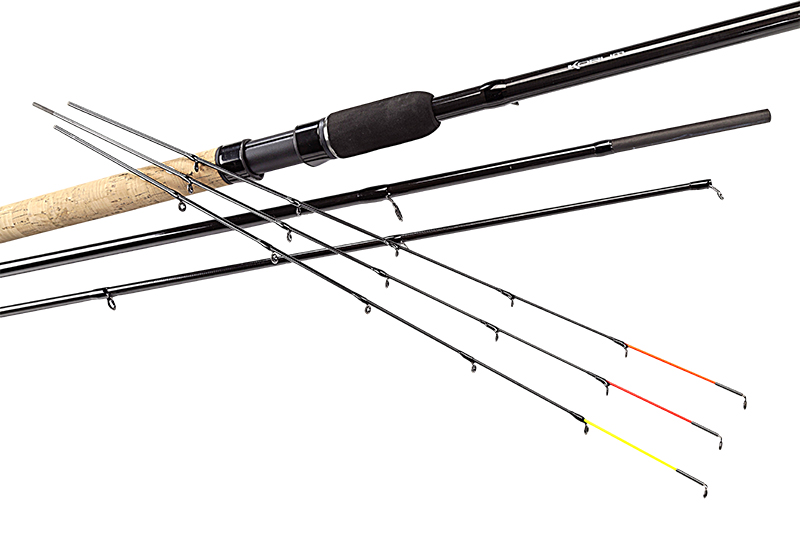
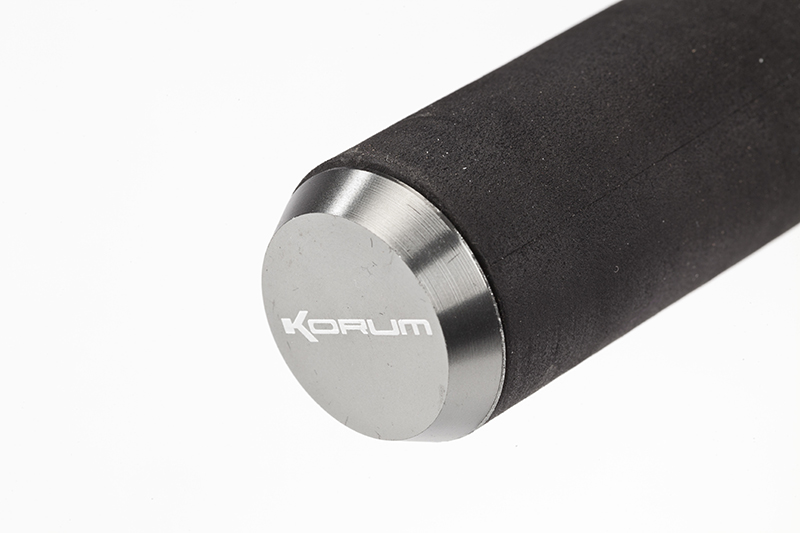
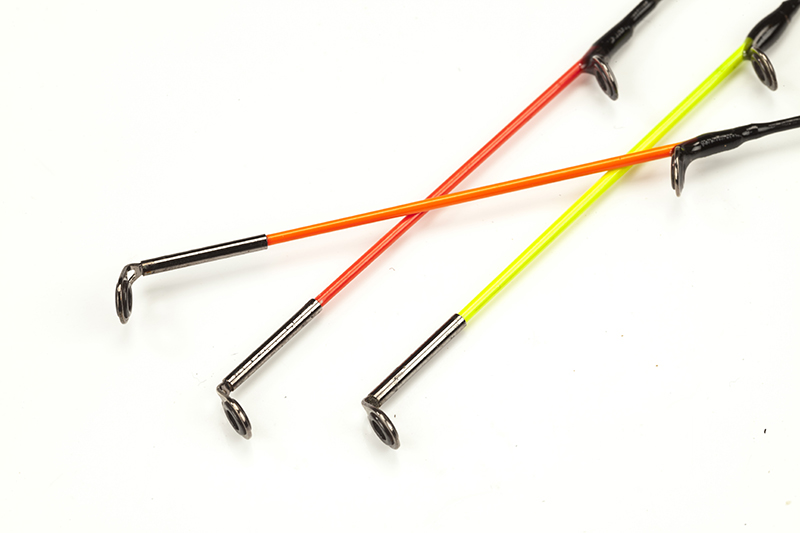

Pleasure and big-fish brand Korum has launched a range of three-piece feeder rods that are sure to be a huge hit. The eight-strong collection features models ranging from 11ft to 13ft, and covers all short, medium or long-casting ranges. The rods are perfect for all types of feeder fishing on both rivers and stillwaters and have maximum casting weights running from 45g to 180g.
11ft Feeder 45g
Ideal for lakes where feeders need to be cast accurately at short or medium distances. A versatile rod with a line rating of 4lb-8lb, it is supplied with three 2.65mm colour-coded quivertips: orange (light), yellow (medium) and red (heavy).
PAY AROUND
£44.99
12ft Feeder 45g
Described by Korum as a ‘fantastic all-rounder’ with plenty of backbone, it has
a 4lb-8lb line rating, and comes with three 2.65mm colour-coded quivertips (light, medium and heavy).
PAY AROUND
£44.99
12ft Feeder 60g
A rod with more power for casting larger feeders and making longer casts. It has
a 6lb-8lb line rating and comes with three 2.65mm colour-coded quivertips (light, medium and heavy).
PAY AROUND
£44.99
12ft Feeder 90g
This rod is for large feeders and long casts, but it retains enough tip sensitivity for silverfish work. Ideal for medium-paced rivers, it has a 6lb-10lb line rating and comes with a trio of 3.3mm colour-coded light, medium and heavy quivertips.
PAY AROUND
£44.99
12ft Feeder 120g
The most powerful 12ft model in the series. A good option for fast water, but with a sensitive tip action that allows plenty of options. It has a line rating of 6lb-8lb and comes with three 3.2mm colour-coded quivertips.
PAY AROUND
£44.99
13ft Feeder 120g
As with the two other 13ft models in the range, this rod has a slightly more powerful tip for improved casting distance and accuracy. It has a line rating of 6lb-10lb, and comes with three 3.2mm colour-coded quivertips.
PAY AROUND
£49.99
13ft Feeder 150g
More power and a faster casting action make this rod ideal for when long casts and heavy feeders are the order of the day. Great for large, open stillwaters and fast-paced rivers. Carries a line rating of 6lb- 10lb and comes with three 3.2mm colour-coded (light, medium and heavy) quivertips.
PAY AROUND
£54.99
13ft Feeder 180g
With a casting weight of 180g, this powerful rod will comfortably launch feeders beyond 100m. Boasting large-diameter guides, it can also be safely used with shockleaders. It has a line rating of 6lb-10lb, and comes with three 3.2mm colour-coded (light, medium and heavy) quivertips.
PAY AROUND
£54.99
Browning Commercial King2 Medium Pellet Waggler rod
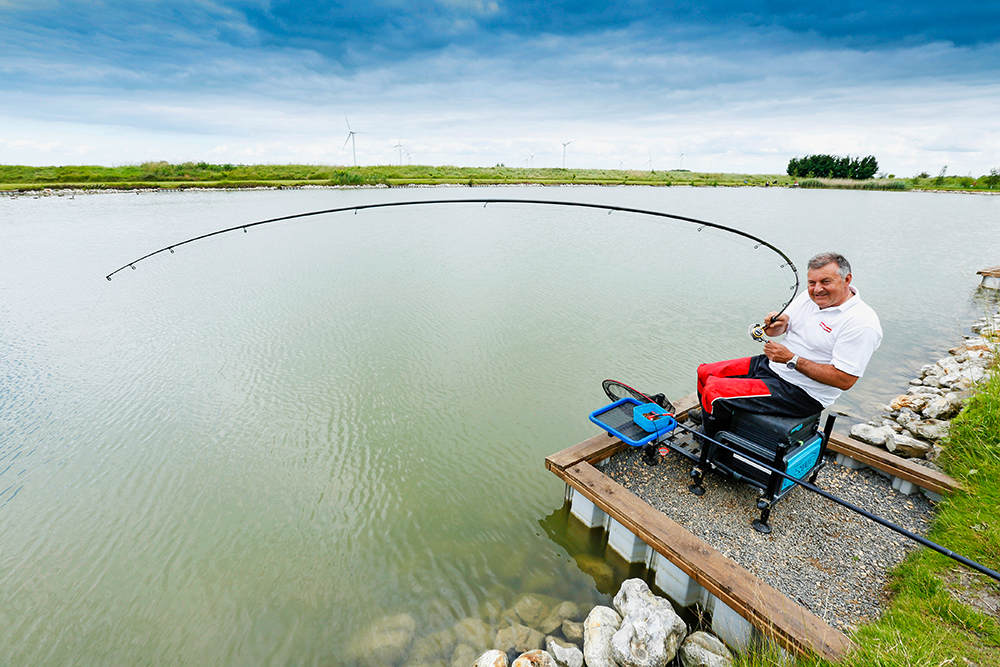
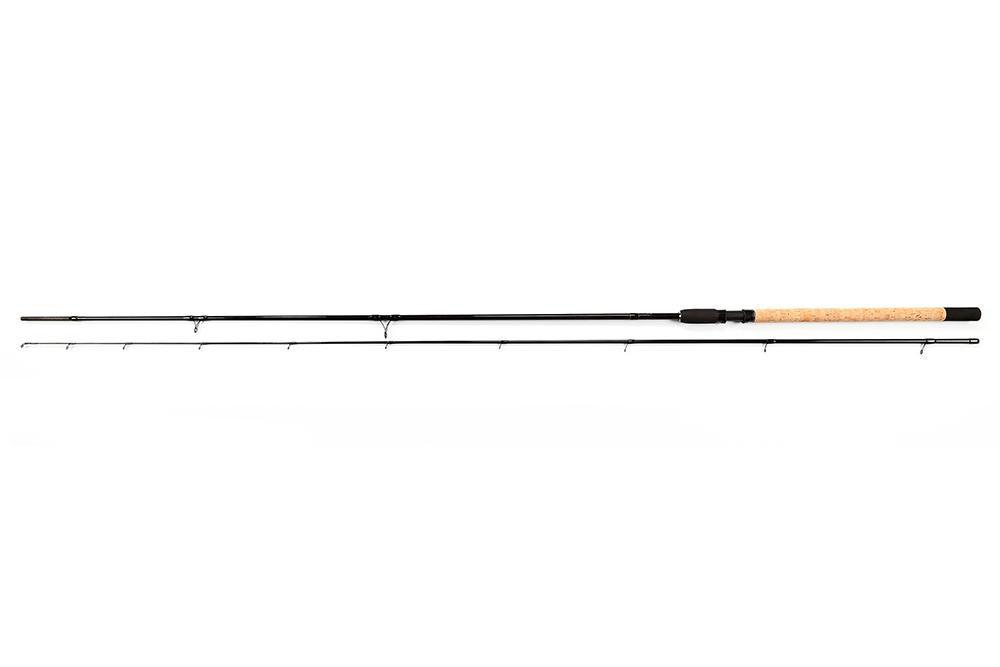
QUICK FIX
Top section: The top section of the rod has
a quick tip action with a fast recovery rate. This allows you to make longer and smoother casts.
Fittings: High-quality line guides are used throughout, producing super-slick casts no matter how great the diameter of your line.
Blanks: Made from ultra-slim high-modulus carbon blanks, they have two equal lengths so that they are ideal for carrying ready made up.
Action: The rods have a perfect parabolic non-locking action which is ideally suited to commercial fishery carp of any size.
Handle: The new Commercial King2 rods
are designed with shorter cork handles so that they can be more easily manoeuvred around the angler’s body.
PAY AROUND
£69.95
Browning has revamped its range of Commercial King rods.
The latest models retain many of the build characteristics of the originals – slim carbon blanks, two equal-length sections and a responsive, progressive action.
However, Browning has further refined its best-selling UK range with improved cosmetics, beefed-up casting prowess and a tweak to provide a little more power through the mid-sections.
All this has been accomplished without Browning significantly hiking up its prices, which something to be applauded.
So, with the summer sun in full water-warming mode and carp cruising about all over the surface of nearly every lake I have visited in the past two weeks, it made perfect sense to take a closer look at Browning’s latest Commercial King2 Pellet Waggler rods.
These 11-footers come in Medium and Power versions, the latter boasting around 15 per cent more stiffness and power for situations involving bigger fish, or casting heavier floats up to 30g.
My chosen test venue, The Pool at Fields End Fishery in Cambridgeshire, is noted for its mixed stocks, so I chose the Medium model with a maximum casting weight of 20g. This is ideally suited to lighter floats, hooks and lines.
Assembling the rod, it’s immediately apparent that this is quality kit. At only 175g, it’s nicely balanced, with a super-quick tip action and fast recovery. That means it doesn’t wobble around much, making long, smooth casts easy to achieve.
My float choice was the small flighted John Bonney model that comes free on the front of Angling Times this week. It flew across the Pool to a range of 25m with no effort. The slightly reduced handle length made feeding with a catapult equally effortless, and that made very short shrift of what can otherwise be a rather tiresome ‘feed and cast’ routine.
Feeding little more than half-a-dozen 6mm pellets every 20 seconds or so, it wasn’t long before dark shapes were coming in to feed as soon as the pellets hit the water. But, as often happens on a well-fished venue, as soon as the float splashed down, they high-tailed it out of the swim.
The answer to this fishy conundrum is to feed twice, immediately before and after casting. You will also need to feather the line, so that the float lands with a gentle kiss on the surface. Get it right, bites will be savage. You now need to get them out of the killing zone as quickly and quietly as possible, by keeping the rod low, simultaneously reeling and pulling back.
For this you need full confidence in your rod, and reel for that matter, keeping the fish moving without pulling the hook, breaking the line or having the fish charge back through the feeding shoal. Basically you are pushing your kit to it limits, and it needs to respond and perform in equal measure.
This latest Commercial King2 Medium Pellet Waggler rod does exactly that. The added bit of muscle Browning has added kicks in as the blank approaches full parabolic compression, but its non-locking action provides enough of a safety factor for you to be able to dish it out without fearing the worst.
I was also impressed with the rod’s ability to deal with fish other than carp. During the live test some pretty hefty ide decided to have a go. These are not exactly cage fighters, but can be welcome weight builders in matches.
Their lolloping ‘fall-over’ swimming action means they are effectively dragged towards the net – hook-pulls happen all too often when using carp-style pellet waggler tactics. But not with this rod. It handled everything from near-double-figure carp, through to heavyweight ide and big roach, with aristocratic disdain.
VERDICT
I really liked the original Browning Commercial King rods, rating them right up there with many of the best models then available.
These latest rods look, feel and perform with every bit as much style, but with a little more bite.
Improvements to the cosmetics and furnishings give them an expensive top-end look which belies their very sensible price tags.
Mark Sawyer
Shimano Beastmaster CX Commercial 9ft-11ft Float rod
The new Shimano Beastmaster CX rod range has been developed for small to medium-sized carp. Much modern match fishing takes place at 30 yards, so each CX Commercial blank has a parabolic fish-playing action that absorbs the power of the fight, preventing hook-pulls. There are Feeder and Float rod versions, ideal for all but the heaviest Method, straight lead and pellet waggler tactics.
PAY AROUND
£109.99
Hooray – at long last it looks like summer is on its way!
The daffs have bloomed, and on all the fisheries I have visited broods of downy ducklings swim in unison as if tied together.
As the water warms, carp are drawn inexorably towards the surface for some community sunbathing. So how can we tempt them into taking our baits?
Floating dog biscuits work, but they are banned on commercials so it’s down to pellet waggler, or wag and mag tactics.
Unless I have to cast miles, an 11ft two-piece float rod is usually my weapon of choice. Sometimes, though, especially when targeting F1s on snake lakes, casting tight up against islands or even dobbing, there’s definitely a case for an even shorter rod. Its added casting accuracy can pay dividends.
As if to second-guess me, Shimano has released a brilliant line-up of new Beastmaster CX Commercial rods, including this rather nifty 9ft/11ft model.
Not only will it cope with most commercial fishery float work, but the carbon blank includes a 27ins dolly-butt section that fits snugly into the cork and EVA handle, giving you a well-balanced 9ft rod.
In their shorter mode, dual length float rods can either be much too pokey, or limper than a Julian Clary handshake, leading to constant hook-pulls or protracted battles with fish on an under-powered blank. But after spending time with the new Beastmaster CX 9-11 I can happily report that this classy looking all-black blank offers a medium parabolic action, with an almost tippy casting performance, at both its 9ft and 11ft lengths. I’d guess that England Feeder international Rob Wootton and ex-Shimano consultant Mark Pollard had quite a bit of input into this rod’s development.
Despite its slim profile and lightweight Bio-fibre carbon build, the blank has more than enough beef to cope with the biggest of fish. It’s possibly better suited to casting floats from 4AAA upwards than it is small wagglers, and Shimano has given it a maximum casting weight of 15g, which gives it plenty of all-round scope.
VERDICT
This great new float rod from Shimano is aimed squarely at the match angler – well thought out, cleverly designed, with a build quality and furnishings normally only associated with top-end flagship models. The 9ft/11ft blank has the flexibility to be used on all types of commercials with reel lines and hooklengths of 4lb-8lb.
Mark Sawyer
Shakespeare Superteam Match 13ft rod
TECH SPEC
Length: 13ft
Power rating: 6lb
Pieces: 3
Handle: Cork/EVA
Rings: Zirconium
Extras: Side keeper ring
PAY AROUND
£89.99
You could do worse than use the Redditch tackle giant’s products down the years as a means of charting the development of the modern match fishing rod in terms of materials, furnishings and specifications.
A potted history of Shakespeare notables would show the fibreglass Match International as a rod ahead of its time. This was followed by the excellent, if rather expensive, President which I believe was the first carbon fibre rod to be built with a spliced-in tip.
Then we had the superb Mach 2 Boron which held centre stage with matchmen for many seasons, but was eventually superceded by the Mach 3 carbon. Since then we have been blessed with the firm’s high-modulus carbon Superteam model, launched in 2014.
Shakespeare did, of course, introduce many other match rods but those listed above were widely recognised as being as good as it got back in the day. Remember, it wasn’t all that long ago that match fishing was all about using a waggler or stick float to catch winning nets of roach, chub, dace, perch or bream, the tool of choice being a 13ft, three-piece.
The finesse to deftly flick a small waggler across a canal, cleanly pick up line from the surface when long trotting and cast bodied wagglers or sliders into deeper water on rivers and lakes, are qualities we expect of any good match rod.
That brings me nicely on to Shakespeare’s Superteam 13ft match rod which really is a jack of all trades and will take all these tasks in its stride. Yes, this rod was first introduced a few years back, but that doesn’t make it in the least bit tired or dated. It remains to this day one of the best all-round match-style float rods that few others can hold a candle to.
The three-piece pencil slim carbon blank is nice and light in the hand, making it easy to hold for long spells, and a requirement of any good river rod. Worthy of note are its zirconium oxide guides that enable almost friction-free line travel, very useful when trotting a river at the pace of its current.
Its fast, progressive action doesn’t lock up under stress, so when you hook into a really big fish the blank will absorb and keep absorbing its runs and lunges with no fear of the line snapping. At the same time it has the backbone to boss fish away from snags.
Live testing the rod was interesting, as I already had some idea about the Superteam’s performance from an earlier Angling Times review. This time, rather than take it to a carp puddle or river, I thought I would test the blank’s sharpness and line pick-up qualities on a deep venue I knew held some big roach and decent ide.
Waggler tackle with small hooks and maggots, coupled with a nagging easterly side wind, wasn’t perhaps the ideal mix for a decent day’s fishing. But I needn’t have worried – Shakespeare’s finest 13ft of carbon cast a hefty three-swan insert waggler with ease and unerring accuracy.
With the float set at 12ft deep, line pick-up speed was central to hitting bites and the rod didn’t disappoint, connecting time and time again with the most tentative of enquiries.
As the fish responded to the feed they started coming up in the water, and bites became lightning-fast.
Now the line needed to be whipped from the surface at a rate of knots, and yet again the rod performed impeccably. Not merely a jack of all trades but a master of them all.
VERDICT
Another pure class floatfishing rod from the Shakespeare stable and perfect for silverfish, the Superteam 13ft is tactically flexible and ultra-reliable. Use it with confidence, however light the terminal tackle. Its anti-locking nature and progressive action allows it to cope with sizeable fish, something that cannot be said of many old-school float rods.
Middy Baggin’ Machine Synaptic Duo rod
TECH SPEC
Two tops: Waggler and Feeder
Features: F-Lined Guides, hook retainer, two spare quivertips, Synaptic carbon design, ergonomic reel seat.
Casting weights: 2g to 25g Wagglers; 10g to 45g Feeders.
PAY AROUND
£109.99
This Middy Baggin’ Machine Synaptic float and feeder Duo is ideal for anglers on a budget who want a single rod to cover a multitude of different methods.
It has two separate top sections and comes with two push-in quivertips to make up a 10ft feeder rod that’s perfect for parrot cage commercial fishery pegs. With the feeder top, the rod is capable of fishing Method feeders up to 45g as well as cage and blockend feeders and straight leads. It has a soft progressive fish playing action, but with loads of power down the blank, and will handle reel lines up to 10lb with hooklinks up to 6lb. There’s also plenty of power to land double-figure carp, and the rod feels nicely balanced and responsive.
During a live test at the impressively stocked Lou’s Lake at Cambridgeshire’s Decoy Lakes, the rods mettle was well tested with plenty of F1s, as well as the odd larger carp. It cast a fully loaded Method feeder with impressive accuracy up to 30m with ease. The Synaptic blank is made from carbon and glass, which produces a very lightweight, fun-to-use tool, with an almost anti-locking action. Hook pulls are kept to the absolute minimum.
With the waggler top fitted, the rod is still 10ft in length, and will cast floats between 2g and 25g, making it ideal for up-in-the-water pellet waggler tactics. It can handle reellines up to 8lb and hooklinks up to 5lb.
The waggler section has a little more stiffness through its mid-section than the feeder top, but it still retains plenty of cushioning forgiveness, and is more than capable of absorbing last-minute lunges from even the largest of fish at the net, without risking hook pulls.
VERDICT
The Middy Synaptic Duo would make the perfect tool for the summer pleasure angler. Designed for use mainly on commercial carp fisheries, the rod is easy to transport and equally at home fishing a Method feeder or a pellet waggler.
Drennan Acolyte Feeder Plus 12ft rod
PAY AROUND
£189
Tackle giant Drennan has recently added two new models to its top-end Acolyte Feeder series. The latest 10ft and 12ft Plus rods are said to be the most powerful within the family, which includes 10ft, 11ft and 12ft Ultras with lighter actions, as well as an existing 11ft Plus rod.
The 12ft Plus model I tested is constructed using the same super-slim, two-section high modulus carbon blank featured on all Acolyte Feeders. But on this rod its mid to top section areas have been substantially beefed-up, to provide the blank with a higher weight loading point.
This not only aids its casting potential, enabling feeders and leads to be propelled greater distances, it also allows heavier weights up to 60g (2oz) to be used.
Drennan claims casts up to 60m are easily achievable, with even greater distances possible if you have good technique and, having live-tested the model on a large open water venue, I wouldn’t argue.
Other notable features are its stand-off SiC lined guides that help to keep the line well away from the blank, enabling the reel line to move quickly and smoothly through its guides, again to help distance. To that you can add a high-quality original Fuji screw down reel seat, full length 23ins-plus cork handle, and three push-in carbon quivertips, which have been selected to blend in with the rod’s parabolic fish-playing action.
So when, where and how would you use this rod? It’s certainly well suited for large expanses of open water – including rivers – and for all species of big fish.
The blank’s extra backbone provides plenty of casting clout which makes it ideal for all types of feeder and straight-lead tactics, just as I experienced at Lincolnshire’s big-fish mecca Bain Valley at Tattershall Thorpe.
The fishery’s windswept and open Halifax Lake holds some very big carp, which are noted for their fighting qualities. During the warmer months when the water is coloured, these can be caught on a pole in the margins, but once the colour starts to fade away, so do the fish. And like so many big waters in clear conditions, fish tend to shoal up towards the middle of the lake, a good 70m from the bank, more than a decent cast for any type of feeder rod, let alone one with such a slim profile as the Acolyte Plus.
Bread is the key bait, as it is on so many carp lakes in the cold. But Bain Valley is deep, so the punched disks need popping-up some three feet off the bottom to find the fish.
The longer hooklength adds yet another degree of difficulty to the cast. However, a decent sized bomb soon sorted this problem out. I did feel, though, that using an ounce-and-a-half of lead at around 65m-plus, the blank was on the upper limit of its capacities. To be fair, it was a very long chuck, and the Acolyte’s tip recovery post-cast, and its responsiveness, were never found to be wanting.
The rod’s push-in quivertips are faultlessly matched to its carrier section, with the 2.5oz, 3oz, and 4oz carbon quivers ideally suited for Method feeders and all hair-rig tactics.
Once a fish is hooked the blank’s action is surprisingly robust, and enables you to pull very hard without it ever feeling as though it might fold when under pressure – perfect for all big fish, not just carp.
The 12ft length enables a quick contact to be made with fish hooked at distance, and nothing that I caught while live testing, ever felt like it could dominate proceedings, which again for such a light and slim rod is very impressive.
I wouldn’t use it with small hooks and light lines, as I feel it had a little too much stiffness toward the end of the carrier section for gossamer gear, but as it wasn’t designed for that anyway, it’s hardly a criticism. I am, though, surprised that Drennan hadn’t moved the butt guide further down the blank, even if it meant losing a guide further up (think carp rod) as this may have added even more casting prowess.
VERDICT
Another sure-fire winner from Drennan. The Acolyte Plus feeder would be every bit at home on Boddington Reservoir as on the banks of the Severn or Trent. Thanks to its same-length design, and top ‘n’ tail retaining bands it is easily transported ready made-up, and is sure to be popular with long-range feeder fishing fans.
Mark Sawyer
Preston Innovations Competition Pro 12ft Medium Feeder rod
PAY AROUND
Preston innovations Competition Pro 12ft Medium Feeder
RRP: £109.99 (but shop around)
PXR Pro 4000 reel
RRP: £104.99 (but shop around)
Not quite as cheap as chips, but more versatile than a Swiss army penknife, is this tasty pair from the Preston stable.
The three-piece 12ft Competition Pro feeder is as much at home dishing it out on rivers as it is battering them down at your local commercial carp venue. The all-carbon blank is nicely put together, and features an old-school full-length 25in cork handle with screw-down reel seat and EVA thumb grip.
Its seamless, flat spot-free progressive action is ideal when targeting big bream, carp, barbel, tench and, of course, chub. The lightweight blank has just about enough softness at its tip to make reel lines of 4lb-8lb with hooklengths down to 0.12mm diameter feasible and, like all good feeder rods, this one has a very high loading point.
This means that when a feeder is attached, the rod only bends from its tip, enabling its backbone to kick in and propel the feeder forward, rather than just lobbing it up and out, as happens when the weight loading area is too far towards the mid-section.
Other features on this Preston rod, which the manufacturers suggest will cast feeders up to 60 metres, are eight low-profile large diameter lined guides. The six equivalent guides on the two spare quivertips also have enlarged diameters, so if you’re off to Ireland, where heavy shockleaders are often used to cushion long casts and protect against zebra mussels, you shouldn’t suffer the annoyance of having the knots catching in the eyes.
The perfect foil for this rod would be its matching Preston branded reel, the award-winning 4000-sized PXR Pro. This model is ideal for winching in heavy feeders and is packed with features including a lightweight aluminium body, quick-release push button spool (plus one spare), precision front drag system, robust stainless steel hollow bail-arm and hard chrome-plated line roller.
Most importantly it runs smoothly and tirelessly on six stainless steel bearings and generates a 4.9:1 gear ratio.
Live testing tackle in winter can be tricky. With the bigger rivers out of sorts, but fed up with bagging commercial carp, where else could I take the Preston pair to prove their mettle? The light-bulb moment eventually came and we were off to Northamptonshire’s River Ise. A stealthy approach using a small cage feeder packed with liquidised bread, and flake on the hook, would hopefully prove successful. The set-up was simple. The reel was loaded with 5lb mainline straight through to a running feeder, stopped with No.8 shot 12in from a size 10 hook. First cast saw the tip tremble, and then it trembled again before pulling round in a classic chub bite. A spirited fight saw a fair sized fish lunging for the nearside reeds, but the 12ft Competition Pro Feeder had a bit too much backbone for any of that old malarkey, and quickly thwarted my quarry’s escape plans.
Through pouring rain, covered in mud, bread and fish slime, both the Preston items performed faultlessly and they get a huge thumbs-up from me.
VERDICT
If there were such a thing as a ‘one-rod does it all’ feeder model, Preston’s Competition Pro Medium Feeder would comfortable pass the test. Every bit as much at home on a commercial carp fishery as it would be bream-bashing on an Irish lough or fishing a big river for barbel, it’s a great all-rounder. As for Preston’s PXR Pro reel, you don’t have to spend long using one to see why the angling public voted it the best reel in its class last year.
Daiwa Harrier Match 13ft rod
PAY AROUND
£54.99
There was a time not so long ago when a three-piece 13ft float rod was standard issue for all match anglers.
Sheffield, Leeds, Rotherham and Birmingham all boasted legions of matchmen whose angling clubs were linked to massive national industries and working men’s clubs. Every weekend would see charabanc outings to the banks of the Witham, Welland, Trent or Severn, where floatfishing was still king and legering came a very poor second.
The best float rods of the day were mainly built on a Golden Jubilee blank, reappearing as WB Clarke’s
All-England, Milbro Enterprise or Billy Lane Match rods.
The first carbon rods weren’t far away, though, and when Fothergill and Harvey’s carbon blank appeared in 1975 they cost a king’s ransom at £133. The early carbon rods, nowhere as good as today’s, cost the equivalent of over £3,000, as much as you’ll pay for a modern flagship pole.
This history lesson earns a place here because 13ft float rods, once the most popular on the market, have evolved tremendously and are available at a steal of a price.
One such model is Daiwa’s 13ft three-piece Harrier Match, which can be found for as little as £44.99.
The rod is built on a decent enough lightweight blank, making it easy and comfy to hold. Its medium-fast action will cast small 3AAA wagglers with no trouble, and it boasts a full cork handle with an EVA lock-down foregrip, lined guides and a matt low-glare finish.
It isn’t the crispest float rod I have ever come across, and it may lack a bit of finesse. But what it can do in spades is handle whatever comes its way – something I was to find out while I was live testing the rod at Boston’s Westwood Lakes.
I had set my stall out for a net of roach and ide, or maybe the odd bream, but the tea-stained Kestrel Lake looked that dirty, I’d have been content to get a bite from anything.
With Storm Imogen racing with unstoppable force across Lincolnshire, this was far from being the best of conditions for floatfishing.
Still, with a 0.10mm hooklength and size 20 red maggot-baited hook on a slow-falling rig, something would surely have a go… wouldn’t it?
It seemed like an age for the bite to come, but eventually it did, and the blaze-coloured float tip sank slowly beneath the surface.
The strike was met by a little more resistance than I had expected, and the rod instantly took on an alarming fighting curve. This action, best described as on the through side of progressive, is pretty much what you want from a float rod if you’re likely to encounter bigger fish.
At first I thought I’d hooked, or even foul-hooked, a carp, hardly what I wanted from a silverfish session, and especially since I was using such lightweight terminal gear.
But as the scrap progressed it became obvious that I had hooked into one of the lake’s legendary barbel.
My balanced tackle was never more welcome than when I slipped the net under a pristine winter Bertram!
The Harrier Match, a long way from being one of Daiwa’s most expensive rods, had absorbed every lunge without my ever breaking sweat that I might get busted up and lose the fish.
Yes, it can be used for small silverfish, but take it from me, the Harrier is capable of an awful lot more when called to battle stations – just like its aircraft namesake, in fact.
VERDICT
On a day when everything but the roach wanted to feed, the Daiwa Harrier proved itself as a great silverfish all-rounder, with enough backbone to cope with much larger quarry when the need arose.
The rod would be well suited to a mixed commercial fishery, where the next bite could come from a matchbox-sized rudd, a powerful carp or, best of all, a belting barbel.
Mark Sawyer
Browning Sphere 10ft Bomb rod
TECH SPEC
Length: 3m (9ft 10ins)
Sections: 2
Max recommended casting weight: 50g
Spare quivertips: 0.5oz, 0.75oz, 1oz, 1.5oz.
Weight: 133g
PAY AROUND
£249.95
Those who regularly read my tackle review pages will be aware that I have been raving about Browning's top-of-the-range Sphere Feeder rods since first clapping eyes on them a year ago.
I adored them at first sight, and was bowled over by their lively, springy and steely feel and seamless non-locking parabolic curves. Live-testing them has proved to be nothing short of stupendous. They have casting power to burn, with recoil-less rigidity matched with a high weight loading area that will propel a feeder or lead a very long distance, even in the hands of a 'standard' distance casting angler like myself.
But - and here's the best bit - somehow the technical boffins at Browning have been able to produce blanks which blend all of that sizzle-factor with an almost imperceptible finesse which only comes into play when you hook a fish. Clever eh?
Faults are hard to find, other than the weight of their price tags, but they are right up there among the best.
Plaudits aside, there was one model left in the Sphere range that I had been waiting patiently to live-test, until the leaves started falling from the trees.
In the comfort of Browning's showroom, this rod felt ideal as a cold-water commercial-fishery tool, ideal for targeting F1s using light lines and small hooks, as well as being able to cope with the odd bigger fish. So as I tackled up on Decoy's unit-packed Beastie Lake, I was hoping for a live test encounter which would live up to my ambitious expectations.
I wasn't disappointed. The first thing you notice is that the blank has a long butt section at 5ft 2ins and a short a (3ft 4ins) carrier section, although when one of its four 23ins glass quivertips are fitted the two sections become equal length, making it easy to carry around as a ready-made.
Browning rates the rod as optimised at around 30m casting distance, which for me was under-gunning its true potential somewhat. My chosen peg was opposite an island end with a paddle type aerator as an added feature. My guess would have been it was around at least a 50m chuck, well above the rod¹s rating, and made even more difficult by the somewhat less than streamlined shape of the 20g pellet feeder I had tied on.
Not a problem! I even had to feather the line a little to avoid an overcast, and once clipped the rod hit the distance every time without fail. All very impressive, but not as impressive as what went on over the course of the next few hours. It¹s called Beastie Lake for a very good reason. Barbel, carp and F1s all grow fat healthy in this fabulous lake, and the Sphere handled them all with consummate ease, even when I had a dabble down the margin.
The resident barbel know every root-end and snag, but the rod pulled them away quickly and cleanly without a creak of complaint. I purposely over-loaded the stress-factor by pulling directly from above in an attempt to make the blank rotate, which in turn makes the guides twist out of alignment but they stayed die-straight throughout the ordeal.
I went through the card with this rod - maggot feeders with small hooks and 0.10mm hooklengths, pellet feeders with heavier lines and hair-rigs, straight lead and pellets - it was faultless. It would happily cope with main lines or braids from 4lb to 8lb and will cast up to 30g weights easily enough. Plus, you can use it with light lines and small hooks as its soft action is very forgiving, so hook pulls are kept to a minimum.
The four push-in glass quivertips are rated 0.5oz, 0.75oz, 1oz and 1.5oz which helps to provide it with sensitivity and durability.
Although it carries a bomb rod tag, the Browning Sphere model shouldn¹t be thought of as an old-school whispish wand designed for winkling out silvers from flooded rivers or canals. It¹s a very modern model with the casting backbone and parabolic fish playing action required for nearly all standard commercial fishery feeder and lead work.
The pencil slim blank has a superb transmission and steely feel, perfectly matched with the forgiving softness that is a hallmark of the Sphere range. If you¹re into the commercial fishery scene then you owe it to yourself to have a closer look.
Daiwa Airity Match and Feeder rods
PAY AROUND
£375-£450
Daiwa has used its tried and trusted Tournament blanks to create this new nine-model Airity series. The extra performance of the latest X45 carbon material is said to offer improved torque and power conversion.
The Airity hybrid 10ft/11ft is every bit as much at home casting a pellet waggler as it is a Method feeder, and will be of great interest to commercial matchman. Look out for an exclusive live test here soon.
Tri-Cast Trilogy 11ft 6ins Commercial Waggler rod
TECH SPEC
11ft 6ins version
Casting weight: Up to 20g
Line rating: 2lb-6lb
12ft version
Casting weight: Up to 30g
Line rating: 2lb-8lb
PAY AROUND
£179.99
This new two-piece 11ft 6ins Tri-Cast Trilogy Commercial Waggler rod offers the keen match angler something rather different to the usual 10ft, 11ft or 12ft rods of this general type.
It is quite capable of casting pellet wagglers up to 20g, but it can handle lighter straight wagglers from 3AAA upwards just as well.
When you first pick up the rod the pencil-slim carbon blank feels a little too light in the hand, and you could be excused for thinking that it would be best suited to F1s, small carp and big silvers, rather than ‘proper’ carp. However, you would be mistaken – as I was after a few hours of boisterous activity on Cedar Lake at Peterborough’s fish-packed Decoy Lakes.
The latest Tri-Cast model took on and beat everything thrown at it, from double-figure carp to barbel almost as big and twice as aggressive. Yes, this rod really is a wolf in sheep’s clothing.
The progressive action has a wonderful degree of elasticity that enables it to bend almost double when put under heavy stress, but there is no suggestion of twist along the guides. The blank simply soaks up the punishment, and what’s more it’s great fun to fish with.
With its low-profile guides set off by bright blue gloss whippings it’s a bit of looker into the bargain.
VERDICT
Don’t imagine that this new rod is nothing more than another version of Tri-Cast’s famed XRS-2K4 model. The Trilogy Commercial has an altogether different fish-playing and casting action, not to mention looks and feel.
It would also make a better ‘all-rounder’ as its lightness and elasticity make it a very versatile rod indeed.
Mark Sawyer
Tri-Cast 11ft Trilogy Feeder rod
TECH SPEC
8ft version
Casting weight: Up to 20g
Line rating: 2lb-6lb
10ft version
Casting weight: Up to 25g
Line rating: 2lb-6lb
11ft version
Casting weight: Up to 30g
Line rating: 2lb-8lb
PAY AROUND
8ft £145.99
10ft £182.99
11ft £196.99
Who remembers (and probably laments the passing of) Carbotec Fast Play Feeder rods? They were so good that they retain their old face value, or even more for the right model.
This new Trilogy Commercial Feeder shares more than a few of its traits. The two-piece blank is probably a bit lighter and slimmer, and doesn’t have quite the same degree of casting clout, but it still has an extraordinary amount of fish-playing elasticity. There’s not a sign of flat spotting, nor does the rod form anything other than a perfect hoop when put under strain. The more you pressure it, the better it gets.
The casting action has a fair bit of hidden backbone spliced into it, and the 11ft model on test threw a 40g flatbed Method feeder more than 40m with little more than a swish.
The rod comes complete with light, medium and heavy push-in carbon quivertips that do nothing to mar its seamless flat-free fighting curve – very commendable of Tri-Cast.
But why on Earth they didn’t add an inch of blaze-coloured paint to the end of each quiver defeats me. Irritating, but that small detail wouldn’t stop me buying one.
VERDICT
I can’t wait to try the shorter 10ft version of this Tri-Cast rod.
I have a feeling it just might be the ultimate snake lake, small pond F1 and big-fish lead rod.
Meanwhile the 11ft model on test casts straight and well, is light in the hand, and has what seems to be a limitless supply of progressive fish-playing clout – it’s pretty special.
Mark Sawyer
Browning Commercial King Micro Waggler 9ft rod
PAY AROUND
£49.95
Fish on commercials are in the mood for food. They’ll pounce on virtually any bait, and even the crudest tactics will catch them.
But all too soon, as autumn arrives, everything changes. To succeed in cooler water a polished and more refined style of angling is needed, and you need to think very hard about your fishing to carry on reaping the rewards.
Finer lines, smaller hooks and smaller baits are all part of the equation, but to match the finer end tackle you need a suitable rod– and this is where Browning’s latest Commercial King Micro Waggler puts in an appearance.
With its abbreviated length, this nine-footer is obviously tailor-made for short-range casting on small commercial pools and snake lakes, rather than wide expanses of water.
But don’t let its lack of inches mislead you into thinking it’s probably a bit too short to handle anything weighing more than a couple of pounds.
The super-lightweight (160g) two-piece carbon blank dishes out more than enough clout to cope with the odd beastie or two.
Ideally, though, the Micro Waggler should be paired with a 2500 or 3000 sized reel loaded with a good sinking 4lb mainline, and used in conjunction with wagglers weighing no more than 15g. With such a set-up, the rod would be ideal for all maggot and 4mm-6mm pellet hookbaits with appropriately sized hooks and hooklengths.
The pencil-slim blank has a fabulous action that allows it to bend through most of its top section, with plenty of power feeding in via the middle and butt, just perfect for putting carp and F1s on the float in their place.
When it comes to playing and landing bigger fish on a shorter rod you’ll be pleasantly surprised – the reduced length seems to give you more leverage, and quickly brings them within easy range of the net.
Casting accuracy is good too (leaving aside ‘operator error!’), making it ideal to work with in typical parrot cage swims hemmed in by reeds.
In the right hands it will cast 35 yards-plus but, as you might expect, line pick-up at this distance isn’t the fastest.
This rod is at its brilliant best when presenting a waggler with precision just beyond your pole line.
We tested our sample rod at Decoy Lakes’ very scenic Willows Lake which is jam packed with F1s, with the odd bigger fish to keep them company. These larger carp have seen it all before, and can prove frustratingly difficult to nail. The best way is to feed 4mm pellets little and often – these fetch them up in the water pretty quickly. Then it’s a case of picking out your target, taking aim, and landing the banded bait right in front of the fish. Sooner or later one will turn and swirl on the bait, giving an instant and very often explosive take – exciting stuff. It’s really dobbing with a waggler, and patience and accuracy are key.
Now I can’t vouch for your patience, but I certainly can vouch for the casting accuracy of the Browning Micro Waggler!
VERDICT
This tiny waggler rod may seem a bit of a specialist tool, but when it’s too windy for the long pole it comes into its own. With its unerring casting accuracy it’s also ideal for far-bank snake lake work.
Mark Sawyer
Middy Nano-Core XZ65 World Elite 10ft Feeder rod
TECH SPEC
- Three special blank graded carbon push-in quivertips of 0.5oz, 1oz and 1.5oz test curves ensure a flat spot-free action, and make the rod suitable for a multitude of feeder applications.
- The rod comes with an original Middy aluminium hooded reel seat ideal for most reel sizes.
- The super-slim 20ins full cork handle makes the rod comfy to hold even when it’s under stress.
PAY AROUND
£209.99
Middy produces some mighty impressive commercial fishery rods these days – everything from short snake lake models to horizon-hitting beasts.
What’s more, there’s something to suit everyone’s pocket.
At the very pinnacle of Middy’s feeder rod range sits the new 10ft Nano-Core XZ65 World Elite, yours for a jaw-dropping £293.99. But panic not, as it can be found at a more realistic price if you shop around.
That said, it’s still a lot to lay out by anyone’s standards, so what exactly would you be shelling out for?
Well, for starters you get an ultra-slim (just 11mm at the butt section), ridiculously light, two-sectioned carbon fibre blank, the result of the very latest Nano-Core technology. This translates into a rod with lightning-fast reflexes, immense strength and flexibility.
The blank has undergone a unique high-pressure vacuum curing process that forces out any tiny air bubbles, ensuring a consistent performance and a flawless finish.
Other luxury touches include three push-in carbon quivertips rated at 0.5oz, 1oz and 1.5oz, seven ceramic-lined double and single SiC Ultra-Flow guides, and a thin full cork handle furnished with a screw-down reel seat.
Middys claims the rod will cast bombs and feeders up to 50g with mainlines up to 12lb and hooklengths up to 8lb.
So far that’s pretty much standard manufacturers’ marketing speak for a commercial feeder rod of this ilk. But in my humble opinion top-end or flagship models should always have that bit extra, the ‘wow factor’ if you will...
You’re already paying for the classy furnishings, fittings and carbon technology, but without that noticeable edge to the rod’s performance all that counts for nowt – and that applies to all tackle brands, not just Middy.
And so to the live test. A favourite water of mine is the peaceful day-ticket Stretton Lakes, just off the A1 north of Peterborough. The fish here are of an average size, and respond to most open-water tactics – ideal helpmates for tackle testing.
Assembling the rod, you cannot help but be impressed by its pencil-slimness – in fact I found the full cork handle a tad too skinny for my own assortment of butt rests, and would suggest that any prospective buyer should look for a small U-bend abbreviated rear rest of the sort favoured by carp anglers.
The sections are not quite equal in length when the carrier section has a quivertip in place, so you need to be extra careful when you’re putting it away ready made-up, even though the classy Middy padded carry bag is more than long enough for the job.
I was not wholly convinced by its suggested 50g maximum casting weight. For me, the top end of the carrier section has a little too much play, and while there is no denying its impressive post-cast recovery speed, this rod is clearly not of the ‘give it a whack’ breed – face it, if you miscast and take out the top section that’s a very expensive mistake to make.
And there end my criticisms. The fact is, the performance of the 10ft World Elite will have you purring with satisfaction. It has a wondrous amount of torque and feel, with a handling aptitude right up there with the very best.
The immaculate gunmetal grey blank has a phenomenal pick-up speed, and its responsiveness to any size of hooked fish actually takes a bit of getting used to. It’s a bit like stepping straight out of your old family saloon and into a works rally car, but once you adapt to the change it’s all systems go – only you won’t have to strap yourself in!
VERDICT
A genuine high-performance rod for the commercial fishery connoisseur, this top-end Middy model will handle most weights of flatbed feeders and straight leads up to 40g (1.5oz). It is equally at home using a maggot feeder with light lines and small hooks for F1s as it would be targeting much bigger fish with bread discs in winter.
Mark Sawyer
Korum 11ft Quiver rod
TECH SPEC
• Line rating: 4-10lb.
• Two piece construction.
• High quality cork handle.
• Screw reel fitting.
• Ideal for feeder work or straight lead.
• Supplied with two quivertips: 1oz & 2oz.
PAY AROUND
£49.99
The rod has a full cork handle and two equal-length sections with a line rating of 4-10lb. There's plenty of power to comfortably launch 2oz feeders when you're targeting fish over the pound mark.
The 1oz and 2oz carbon quivertips are well-matched to the rod with the stiff 2oz tip first choice for using with a Method. The lighter tip would be great on rivers.
If you're the sort of angler who likes to divide his bankside time between rivers, natural lakes, large canals and commercial pools, wouldn’t it be great to have one rod to suit them all?
This super-versatile tool has two equal-length sections and comes with two spare 1oz and 2oz push-in carbon quivers. It really does have a multitude of uses and will turn its full cork handle to anything, from maggot feeder and straight lead fishing on rivers for chub and barbel through to open-ender tench and bream tactics. It’ll also chuck a Method feeder for commercial carp.
Having spent a few hours using the test sample from Korum, I can report that it won’t necessarily lend itself particularly well to finesse feeder tactics using tiny hooks and gossamer hooklengths. So if you’re after a net of roach and skimmers, it sadly won’t fit the bill. However, it is very impressive with fish from 1lb upwards, which is probably why it carries a manufacturer’s line rating of 4lb-10lb, which seems about right to me.
Although this is a rod with multi-venue possibilities, time was somewhat against me for my live-test day so I chose a water containing all sorts of fish, in all sorts of sizes. The picture-postcard day-ticket Stretton Lakes near the A1 in Rutland fitted the bill.
I started the session using a 28g pellet feeder with a banded pellet hookbait, cast tight to an island. This soon caught me a string of stockie carp of 2lb-3lb, which all put a healthy and progressive fish-playing bend in the rod.
Its action is geared towards hard and fast playing power, as opposed to a fancy and forgiving one. But whatever it loses in guile is certainly more than made up for in its casting performance. For an 11ft model it has plenty of poke, can withstand a proper whack, and will easily launch at least 2oz of lead.
The carbon quivertips both work perfectly with the rod, with no sign of flat-spotting or making the blank feel top heavy. I have long been an advocate of using stiff carbon tips for all my Method feeder work and the 2oz tip worked a treat when I switched to a 30g flatbed Method cast towards the far-bank reeds.
Unfortunately for me – and the live test – it was one of those days when the carp were really ‘on the munch’, and despite several hookbait changes the greedy stockies devoured all that was thrown
at them. While emptying it, or as photographer Lloyd Rogers so eloquently put it, ‘hook a duck time’, I pondered as to why it’s never like this in matches…
It also struck me that the Korum rod would be very much at home on snag- strewn small rivers, where the stocks of chub and barbel succumb to straight lead, bread/cheese and meat tactics.
VERDICT
What a great little all-rounder of a rod this is, and it comes with a very reasonable price tag! Ideal for a multitude of legering tactics, it really is every angler’s flexible friend.
Mark Sawyer
Browning Sphere Feeder M 3.90m rod
PAY AROUND
£249.95-£399.95
Browning’s new Sphere rods are aptly described by the European tackle giant as being ‘from a different world’.
Made from the very highest quality carbons, every aspect of their design is engineered to produce a finished product that is as near perfect as it can be.
The Sphere blanks are said to be the slimmest and lightest high-modulus carbon rods available, and features include superb ultra-low-friction ‘skeleton’ SiC guides throughout, plus an ergonomic, weight-reducing handle which transmits more ‘feel’ through to the angler.
Between them the seven Sphere Feeder models cover every possible aspect of feeder fishing, from lightweight two-piece silverfish models through to 4.2m (13ft) firm-actioned rods capable of handling heavy leads in raging torrents.
Browning claims the rods will add yards to your cast, yet remain responsive enough to safely play soft-mouthed fish like skimmers and withstand the thumping head-shakes of really big bream without fear of hook-pulls.
That is quite some claim. I have seen and used many really good bream rods in my time, but nothing has ever been absolutely perfect – until now, that is!
From the moment I first handled these rods in Browning’s German factory I knew they were a bit special. The first clue to their excellence came during a conversation I had with Bob Nudd at this year’s Big One show. Bob excitedly handed me one, proclaiming: “This is the best feeder rod I have ever seen.” Praise indeed from a five-time World Champ with a lifetime of match and festival wins.
Recent sellout match attendances at open-water bream venues such as Peterborough’s Ferry Meadows had brought me a spate of ‘which rod?’ emails. These, along with questions from anglers on the bank asking about distance feeder rods, were all the excuse I needed to ask Browning to send in a Sphere for review.
This they duly did, and I received a 3.90m (12ft) three-piece Feeder M that I was assured would be ideal for long casting to big bream in open water.
Now, let’s clear one thing up, these rods are eye-wateringly expensive, with prices from £249.99 right up to £399.99, so you would expect them to be more than reasonable. However, they do come with four matching push-in tips which offer the ultimate in bite detection.
Settling into permanent peg 127 on Ferry Meadows’ Overton Lake, it was time to get some bait in. Clipped up at a modest 60 turns on the 4000-sized reel, the rod delivered a fully loaded 30g feeder bang on to the spot every time. Even a niggling headwind did nothing to affect accuracy or distance.
After 20 minutes of constant casting to get some feed out, I unclipped the reel, tied on a heavier feeder and unleashed the beast – ‘awesome’ is the only the word that does this rod justice.
The power kicked in through the middle section, the carrier was virtually recoil-less, and 90 turns later the feeder was back in my hand. Now I wouldn’t claim to be the best caster around, probably only just better than average. But never before had I chucked a feeder so far with so little effort.
But would this rod prove too stiff to play a big bream on? We’ve all been there – up pops the feeder, the bream starts shaking its head, and the rod doesn’t cushion the weight of the feeder being tossed around, so out comes the hook.
It’s the saddest sight in match fishing, staring at an empty landing net head with a big swirl behind it.
Suffice to say, this rod handled the situation with consummate ease – every fish was brought to the net early, apparently increasing the likelihood of a hook-pull, but everything stuck fast.
I could go on and on about the virtues of this rod, but I’ll leave you with this thought… don’t buy any other distance feeder rod until you have seen a Sphere.
VERDICT
Without doubt these Spheres are the best rods Browning has ever produced. Casting with breathtaking performance and accuracy, they have unequalled fish-playing powers, and are aesthetically unlike any others. If the rest of the Sphere Feeder series is anywhere near as good as this 12ft medium test model than Browning has created something out of this world.
Mark Sawyer
Matrix Method Master 11ft Feeder rod
TECH SPEC
In this range, there is a choice of 9ft, 10ft, or 11ft, all with casting weights of 20gms to 50gms.
• High modulus carbon blank.
• Semi-parabolic fish-playing action.
• Designed for up to 25m.
• Casting weight: 20gms - 50gms.
• Ideal for fishing the method on the pole line of on snake type lakes.
• Short handle for easy manouvering when casting and playing fish.
• Lightweight, strong double and single leg guides positioned for easy made-up transportation.
• Cork/EVA handle with soft-touch screw down hood reel seat.
• EVA transport holder block holds all sections parallel for easy made-up transport.
• Ideal for all method feeder\pellet feeder fishing.
• Rods break down into two equal lengths.
• Supplied with two (3/4oz, 1oz) interchangeable tips.
• Line rating 4lb - 8lb.
PAY AROUND
9ft £59.99, 10ft £64.99, 11ft £69.99
Matrix has added three new Method Master feeder rods to its range designed to tackle commercial fisheries.
In 9ft, 10ft or 11ft lengths, all three blanks will cast Method feeders weighing between 20g and 50g (0.7oz and 1.7oz), which will cover nine out of 10 pools you’re likely to find yourself pegged on.
At a time when quality short feeder rods can set you back a considerable chunk of wedgeit’s quite refreshing to find that these superbly appointed rods can be had at under £70 a chuck.
So, what’s the catch – if indeed there is one? To find out, and hopefully make a decent catch of my own, I settled into a peg fringed with Norfolk reed on the day-ticket Kingsland Reservoir, just outside Peterborough, equipped with the 11ft version of the Matrix Method Master.
The fish in this deep lake – mainly carp – show a definite taste for baits presented on the Method, especially close in to the margins. This tactic obviously doesn’t test a rod’s casting attributes, but it does put its fish-playing mettle under the spotlight.
Before you even wet a line, one of the first things you will notice when putting together the two equal-length sections of this 11ft blank is its fast taper from butt to tip.
This gives it a high weight loading area toward the tip end of the carrier section and enables the rod to hold pretty much rock-steady before casting.
There’s none of that bouncing around of the feeder that can be such a pain in the butt section – yours!
This lack of movement improves the rod’s distance casting and accuracy, and after half-an-hour of trying out different weights of feeder I can happily report that it will handle 30g flatbed models with very little effort. That said, I felt that the manufacturer’s recommended maximum casting weight of 50g would be overstretching the rod.
No matter, the plus points way outstrip this small negative. The blank is a composite of carbon, glass and resins which together produce a rod lacking in flat spots, and with enough backbone and grunt to tame the odd Barney Rubble.
This rod is immensely enjoyable to use. Bend it like Beckham and it will put fish in the net time and time again.
Indeed, if you’re into your commercial match fishing, it should help you score a good few points over the opposition.
VERDICT
The new Matrix Method Master casts accurately and sufficiently far to cope with the majority of commercial fisheries. The equal length two-piece blank has lots of feel and transmission, and its controlled progressive bend will cope with fish big and small.
This very affordable rod can be used with reel lines between 3lb and 8lb, and is destined to become a firm favourite with all club match anglers on a budget.
Mark Sawyer
Preston Innovations 12ft Pellet Waggler rod
PAY AROUND
£169.99
This 12ft Pellet Waggler rod is the latest addition to the best-selling Carbonactive Mini Plus commercial range from Preston Innovations.
Honed to perfection for casting splasher-type floats and big pellet wagglers on open-water venues such as Viaduct, Barston and Meadowlands, this rod was developed with input from talented match angler Andy Power.
Andy can list wins in the Maver Match This and UK Champs, as well as qualifying for three Fish O’Mania finals, in a long line of achievements.
In a chat I had with Preston’s brand manager Scott Geens about the ins and outs of the blank’s construction, he told me that Andy had netted fish to over 20lb from Viaduct during its field trials, so no worries on that score!
I was lucky enough to be given an exclusive preview of the new Preston tool, and I never pass up the chance of chucking a big pellet waggler around – besides, the sun was shining.
So I found myself pulling up in the car park of the Canal and River Trust’s day-ticket Engine Pool on the Earlswood complex, armed with little more than a few bags of 8mm pellets for bait and feed, and a box of distance-casting wagglers.
Engine regulars will know just how fickle this water can be. It’s very much feats or famine, but with rock-solid information that the pegs in the high 70s were rammed with fish, my confidence of nailing some proper lumps was riding high.
It was less buoyant after three-and-a-half hours of constant casting and feeding, feeding and casting, swapping between wagglers of the splasher, pellet, clear, loaded and unloaded kind, even some with popper discs.
Having gone through every permutation of floatfishing up in the water, all I had to showfor my endeavours was sore knuckles from what must have been a thousand raps from the pouch of my catty.
You could say my interest was flagging somewhat.
My photographer, Lloyd, had taken to doing ‘wildlife’ snaps – well, that’s what he called them, but I never realised that insects wore Lycra shorts and went jogging round lakes!
With time pushing on, what had I learnt? Well, the Preston 12ft Pellet Waggler rod has quite a fine tip for what is basically an animal tamer.
It will cast just about anything you care to tie on to the reel line, bar possibly a bagging waggler – anything else isn’t a problem.
Even the largest vaned pellet waggler from John Bonny (the Mad Hatter of float makers) can be cast completely out of sight.
I had matched the rod with a 6lb reel line – with 8lb your casting distances would suffer as the guides are all of standard match size to handle thinner diameter lines better. I’d recommend you to play your cards right and stick to 6lb line, not going higher or lower.
Then it happened. The float landed with an angel’s caress, to be greeted with a swirl as an Engine Pool brute couldn’t resist what was obviously my above-standard banded pellet presentation – or perhaps it was down to the fact that it was now getting dark. It matters not – the blank swept the line up in a none too sloppy manner from the surface, then kicked into its progressive fish-playing action.
Now I could finally see the benefits of all that field-trialling. Yes, the rod has unbridled power, but it’s all been channelled into the blank’s middle section. When you lean into a fish it absorbs then dictates… you know you’re in charge.
It’s a strange thing with carp that sometimes, if they feel they are on the losing side from the start, they all but give up. Right at the net, the Earlswood projectile made a half-hearted bid for the legs of the platform, but a smart side swipe from the rod brought it straight up on top and into the pan.
How good is that?
VERDICT
This classy rod from the Preston Mini Plus stable has plenty of brutish power tempered by just the right amount of finesse, and the build and finish are both top-notch.
It’s quite capable of dealing with the largest of fish, but it’s fun to use and sure to become a favourite with anglers visiting big open-water venues this summer.
Mark Sawyer


